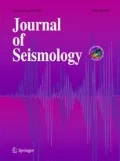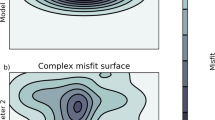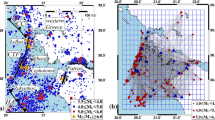Abstract
The generalized inversion technique (GIT) of earthquake recordings is a useful tool in retrieving seismic source spectra, attenuation path parameters and site transfer functions (TF). Further understanding of these three fundamental factors which control seismic ground motion constitutes one of the main challenges in seismology. Especially, the site TF estimation is an important objective that can significantly contribute to seismic hazard assessment. In this study, a parametric GIT algorithm (in MATLAB (The MathWorks, Inc., Natick, Massachusetts, United States, 2017)), based on the one proposed by Drouet et al. (Bull Seism Soc Am 98:198–219, 2008a), is developed, by introducing distance- and regional-dependent attenuation parameters for geometrical spreading and anelastic attenuation terms, respectively. This step is aimed at a more detailed investigation of attenuation path, anticipating to improve the knowledge of all three fundamental factors controlling seismic ground motion. The algorithm is based on a Gauss-Newton iterative inversion method, using initial reasonable model parameters. Source term is parametrically investigated for seismic moment and corner frequency, which can be simultaneously controlled with respect to stress drop. A synthetic dataset, approximating a simplified real dataset was inverted by the proposed inversion algorithm examining its computational validity. Four tests were implemented, with or without reference condition, providing encouraging results. The applicability of the algorithm is supported by the inversion of a real dataset which was also examined by Grendas et al. (Bull Earthq Eng 16:5061–5094, 2018) using a uniform attenuation model in GIT. Approximately 9% reduction of the misfit between real and computed data from the inverted model data is achieved, showing the effectiveness of the proposed algorithm.















Similar content being viewed by others
Data availability
The MATLAB scripts of the GIT algorithm proposed in this study are publicly available up on request to the authors.
References
Aki K, Richards PG (2002) Quantitative seismology. Sausalito, Calif: University Science Books
Andrews DJ (1986) Objective determination of source parameters and similarity of earthquakes of different size. Earthquake source mechanics 37:259–267
Bindi D, Pacor F, Luzi L, Massa M, Ameri G (2009) The M w 6.3, 2009 L’Aquila earthquake: source, path and site effects from spectral analysis of strong motion data. Geophys J Int 179(3):1573–1579
Boore DM, Boatwright J (1984) Average body-wave radiation coefficients. Bull Seismol Soc Am 74(5):1615–1621
Boore DM, Joyner WB (1997) Site amplification for generic rock sites. Bull Seism Soc Am 87(2):327–341
Borcherdt RD (1970) Effects of local geology on ground motion near San Francisco Bay. Bull Seismol Soc Am 60(1):29–61
Brune JN (1970) Tectonic stress and the spectra of seismic shear waves from earthquakes. J Geophys Res 75(26):4997–5009
Brune JN (1971) Correction. J Geophys Res 76(20):5002
Castro RR, Anderson JG, Singh SK (1990) Site response, attenuation and source spectra of S waves along the Guerrero, Mexico, subduction zone. Bull Seismol Soc Am 80(6A):1481–1503
Drouet S, Chevrot S, Cotton F, Souriau A (2008a) Simultaneous inversion of source spectra, attenuation parameters and site responses: application to the data of the French accelerometric network. Bull Seism Soc Am 98(1):198–219
Drouet S, Triantafyllidis P, Savvaidis A, Theodulidis N (2008b) Comparison of site -effects estimation methods using the Lefkas, Greece 2003 earthquake aftershocks. Bull Seism Soc Am 98:1198–1219
Drouet S, Cotton F, Gueguen P (2010) Vs30, k, regional attenuation and Mw small magnitude events accelerograms. Geophys J Int 182(2):880–898
Drouet S, Bouin M-P, Cotton F (2011) New moment magnitude scale, evidence of stress drop magnitude scaling and stochastic ground motion model for the French West Indies. Geophys, J Int 187:1625–1644
Edwards B, Allmann B, Fäh D, Clinton J (2010). Automatic computation of moment magnitudes for small earthquakes and the scaling of local to moment magnitude. Geophys, J Int 183(1):407–420
Grendas I, Theodoulidis N, Hatzidimitriou P, Margaris B, Drouet S (2018) Determination of source, path and site parameters based on non-linear inversion of accelerometric data in Greece. Bull Earthq Eng 16(11):5061–5094
Haghshenas E, Bard P-Y, Theodulidis N (2008) Empirical evaluation of microtremor H/V spectral ratio. Bull Earthq Eng 6:75–108
Hanks TC, Kanamori H (1979) A moment magnitude scale. J Geophys Res Solid Earth 84(B5):2348–2350
Hartzell SH (1978) Earthquake aftershocks as Green’s functions. Geophys Res Lett 5(1):1–4
Hashida T, Stavrakakis G, Shimazaki K (1988) Three-dimensional seismic attenuation structure beneath the Aegean region and its tectonic implication. Tectonophysics 145:43–54
Hassani B, Zafarani H, Farjoodi J, Ansari A (2011) Estimation of site amplification, attenuation and source spectra of S-waves in the East-Central Iran. Soil Dyn Earthq Eng 31(10):1397–1413
Hatzidimitriou PM, Papazachos CB, Kiratzi AA, Theodoulidis NP (1993) Estimation of attenuation structure and local earthquake magnitude based on acceleration records in Greece. Tectonophysics 217:243–253
Hough SE, Seeber L, Lerner-Lam A, Armbruster JC, Guo H (1991) Empirical Green’s function analysis of Loma Prieta aftershocks. Bull Seismol Soc Am 81(5):1737–1753
Iwata T, Irikura K (1988) Source parameters of the 1983 Japan Sea earthquake sequence. J Phys Earth 36(4):155–184
Kagami H, Duke CM, Liang GC, Ohta Y (1982) Evaluation of site effect upon seismic wave amplification due to extremely deep soil deposits. Bull Seism Soc Am 72:987–998
Kovachev SA, Kuzin IP, Shoda OY (1991) Attenuation of S waves in the lithosphere of the Sea of Crete according to OBS observation. Phys. Earth Planet, Inter 69:101–111
Lermo J, Chávez-García FJ (1993) Site effect evaluation using spectral ratios with only one station. Bull Seismol Soc Am 83(5):1574–1594
Mandal P, Dutta U (2011) Estimation of earthquake source parameters in the Kachchh seismic zone, Gujarat, India, from strong-motion network data using a generalized inversion technique. Bull Seismol Soc Am 101(4):1719–1731
MATLAB (2017) The MathWorks, Inc., Natick, Massachusetts, United States
Milana G, Barba S, Del Pezzo E, Zambonelli E (1996) Site response from ambient noise measurements: new perspectives from an array study in Central Italy. Bull Seismol Soc Am 86(2):320–328
Mueller CS (1985) Source pulse enhancement by deconvolution of an empirical Green’s function. Geophys Res Lett 12(1):33–36
Nakamura Y (1989) A method for dynamic characteristics estimation of subsurface using microtremor on the ground surface. QR Railway Tech Res Inst 30(1):25–33
Nakano K, Matsushima S, Kawase H (2015) Statistical properties of strong ground motions from the generalized spectral inversion of data observed by K-NET, KiK-net, and the JMA Shindokei network in Japan. Bull Seismol Soc Am 105(5):2662–2680
Ortiz-Alemán C, Reyes-Olvera M, Iglesias-Mendoza A, Orozco-Del-Castillo MG, Hernández-Gómez JJ (2017) Estimation of source; path and site effects at MASE array stations: a comprehensive study. Geofis Int 56(1):71–85
Oth A, Parolai S, Bindi D, Wenzel F (2009) Source spectra and site response from S waves of intermediate-depth Vrancea, Romania, earthquakes. Bull Seismol Soc Am 99(1):235–254
Papazachos CB (1992) Anisotropic radiation modeling of macroseismic intensitites for the estimation of the attenuation structure of the upper crust in Greece. Pure Appl Geophys 138:445–469
Perron V, Gélis C, Froment B, Hollender F, Bard PY, Cultrera G, Cushing EM (2018) Can broad-band earthquake site responses be predicted by the ambient noise spectral ratio? Insight from observations at two sedimentary basins. Geophys J Int 215(2):1442–1454
Polatidis A, Kiratzi A, Hatzidimitriou P, Margaris B (2003) Attenuation of shear-waves in the back-arc region of the Hellenic arc for frequencies from 0.6 to 16 Hz. Tectonophysics 367:29–40
“Tarantola, A. (2005). Inverse problem theory and methods for model parameter estimation. Society for Industrial and Applied Mathematics.”
Wang H, Ren Y, Wen R (2017) Source parameters, path attenuation and site effects from strong-motion recordings of the Wenchuan aftershocks (2008–2013) using a non-parametric generalized inversion technique. Geophys J Int 212(2):872–890
Acknowledgements
We are grateful to Professor H. Kawase for his valuable suggestions and comments that improved the quality of this paper. The digital maps, presented in this study, were created by the use of the free software: Generic Mapping Tools (http://gmt.soest.hawaii.edu/, Wessel and Smith 1998).
Funding
This study is based on a part of a PhD under a scholarship of ‘I.K.Y’, funded by the progamme ‘Human research potential support through doctoral research implementation’ and financial resources of the operational Program ‘Human resources development, Education and Lifelong learning’, 2014–2020.
Author information
Authors and Affiliations
Corresponding author
Additional information
Publisher’s note
Springer Nature remains neutral with regard to jurisdictional claims in published maps and institutional affiliations.
Supplementary information
ESM 1
(DOCX 140 kb)
Rights and permissions
About this article
Cite this article
Grendas, I., Theodoulidis, N., Hollender, F. et al. A GIT algorithm for simultaneous estimation of seismic source, site response and regional-distance dependent attenuation parameters: application to synthetic and real data. J Seismol 25, 575–598 (2021). https://doi.org/10.1007/s10950-020-09975-8
Received:
Accepted:
Published:
Issue Date:
DOI: https://doi.org/10.1007/s10950-020-09975-8




